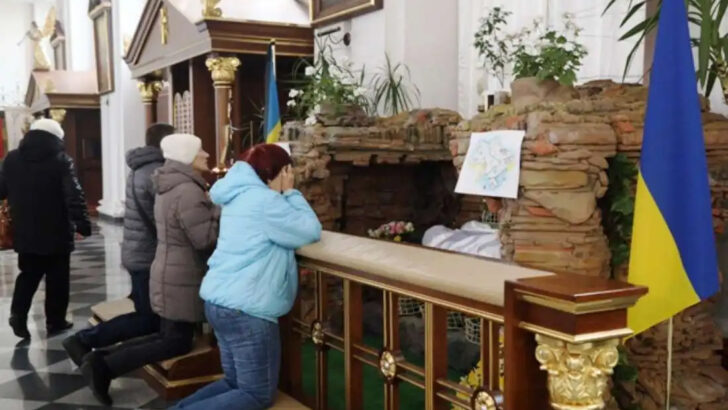The recent Russian invasion of Ukraine and the ensuing war have highlighted for many of us in Western Europe the fact that oppression and persecution have never been far from the people of Ukraine.
This is certainly the case with regard to religious persecution. Yet they have remained committed to their Christian Faith and have exhibited a remarkable resilience in doing so.
From my own experience of visiting the Ukraine in earlier years I can speak from personal observation.
Traditionally the two major Christian denominations in the country are the Ukrainian Orthodox Church and the Catholic or Uniate Church.
The former is centred mainly in the East and South, the latter to a certain extent in the North but mainly in the West. Between 1918 and 1991 (when Ukraine was part of the Soviet Union) the Christian Churches were subjected to sustained, and at times savage suppression.
Definitive
In the definitive history of Christianity in the Ukraine the section dealing with the 20th Century is little more than a catalogue of the murder, imprisonment, and harassment of both Catholic and Orthodox priests and their fellow-Christians.
At the Papal Synod in Rome in 1974 Cardinal Josyf Slipyj. Patriarch of the Ukrainian Catholic Church, stated that the Ukrainian Church had sacrificed “mountains of bodies and rivers of blood”. He did not exaggerate.
The Soviet Union imploded in 1991. As a result, a number of central and eastern European countries became independent. Among them was the Ukraine. In the independent Ukraine religion was no longer outlawed and people were free to practise their religions.
And most of the churches, which had not been demolished under the communist regime, were handed back to their communities. Under the former regime they had been used as archives, concert halls, libraries, and for other various commercial purposes.
I have had personal experience of this scene. During a trip on the river Dnieper from Kyiv to Odessa in September 1997 I was able to witness how the Ukrainian Christians emerged into the public arena.
In the new situation people literally took the symbols of their religious faith out of their homes. Children brought icons to school and set them up in their classrooms. Bus drivers proudly displayed splendid icons in their buses. If a woman wore a necklace it invariably had a large or small cross and, occasionally, men wore these also.
Formidable
Nonetheless priests faced a formidable challenge in their task of re-evangelisation in the new Ukraine. Over 70 years of Soviet social domination had left an oppressively materialistic ethos. Very few of the thousands of statues of Lenin throughout the country had been taken down from their plinths. Even after their dismissal from office, Communists managed to cause ongoing difficulties for Christians.
In 1946 the Soviet government handed over the churches of the Catholics in the Western Ukraine to the local Orthodox Church, mainly because the latter was more pliable in the face of State oppression. From 1991 Catholics had been reclaiming their churches. This led to serious acrimony and occasionally communal violence.
I visited the two Roman Catholic churches in Kyiv. The first was a very large Gothic-style cathedral on a main street. It had been substantially restored after World War II and, thereafter, used as a municipal concert hall, a large organ having been built in the sanctuary. From 1991 the local Catholic community had the use of the church for weekend Masses. Through the week they had access to it during the day, but each evening it was used for concerts.
The other Catholic church in the city was an ‘active’ church. Built 150 years ago in the Greek style it was handed back in 1991 in a deplorable state, having been used as a general warehouse. However, it had been beautifully renovated and provided three Masses daily.
There were two Catholic churches in Odessa (now seized again by the Russians). Both of these were in a state of disrepair. I concelebrated Mass in the cathedral. It presented a sad spectacle and a sad story. Formerly a magnificent building as befitted a large and multi-cultural city, it was taken over by the Communists.
They destroyed or removed all the paintings, pictures and statues. The marble of the cathedral was taken to decorate a new railway station. The bodies of archbishops and other dignitaries buried in the cathedral were dug up and simply disposed of.
Two floors were added to the building and it was used as a sports hall until 1991. It had been only partially restored. As a result I found that Mass could be celebrated only in a side-chapel.
Large display boards were put to good use in the churches. They had a detailed presentation of the physical history of each church: the initial plans, early sketches, photos of them when they were used for other purposes, their dilapidated state when handed back, their ongoing re-building and refurbishment.
The parishioners and all and sundry were thus reminded of the oppression and persecution of the not very distant past. And no doubt such memories would explain the determination and the intensity with which Ukrainians rallied to the defence of their fatherland following the recent Russian invasion.
The Orthodox Ukrainians have effectively broken with the Patriarchate of Moscow to adhere to the more ancient and might one say more properly orthodox Patriarch of Constantinople in Istanbul in what is now Turkey. And so, sadly, global political affairs still interfere with religious life in Eastern Europe.


 The faithful pray, perhaps for peace, in the Catholic Cathedral in Odessa.
The faithful pray, perhaps for peace, in the Catholic Cathedral in Odessa. 